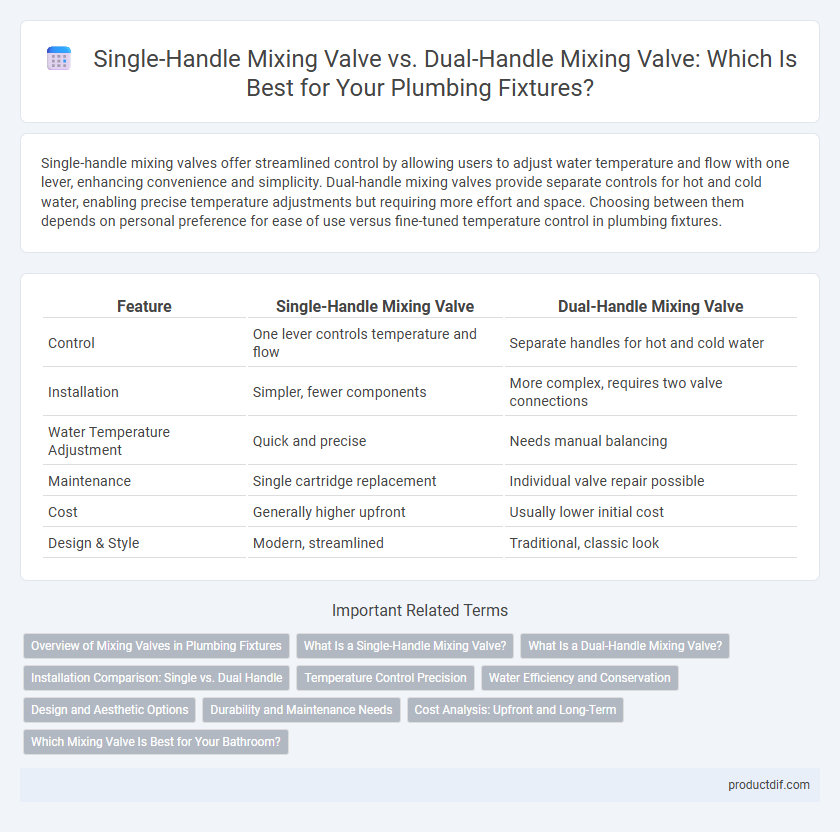Single-handle mixing valves offer streamlined control by allowing users to adjust water temperature and flow with one lever, enhancing convenience and simplicity. Dual-handle mixing valves provide separate controls for hot and cold water, enabling precise temperature adjustments but requiring more effort and space. Choosing between them depends on personal preference for ease of use versus fine-tuned temperature control in plumbing fixtures.
Table of Comparison
| Feature | Single-Handle Mixing Valve | Dual-Handle Mixing Valve |
|---|---|---|
| Control | One lever controls temperature and flow | Separate handles for hot and cold water |
| Installation | Simpler, fewer components | More complex, requires two valve connections |
| Water Temperature Adjustment | Quick and precise | Needs manual balancing |
| Maintenance | Single cartridge replacement | Individual valve repair possible |
| Cost | Generally higher upfront | Usually lower initial cost |
| Design & Style | Modern, streamlined | Traditional, classic look |
Overview of Mixing Valves in Plumbing Fixtures
Single-handle mixing valves streamline temperature control by combining hot and cold water adjustments into one lever, offering precise and convenient regulation in plumbing fixtures. Dual-handle mixing valves separate hot and cold water controls, allowing independent adjustment for customized temperature settings, commonly found in traditional bathroom and kitchen sinks. Both valve types ensure efficient water flow management and temperature mixing, crucial for safety and comfort in residential and commercial plumbing systems.
What Is a Single-Handle Mixing Valve?
A single-handle mixing valve combines hot and cold water controls into one lever, allowing precise adjustment of water temperature and flow with a single motion. This valve type enhances convenience and efficiency by reducing the need to balance two separate handles, making it ideal for modern plumbing fixtures. Its streamlined design also minimizes installation complexity and improves user experience in sinks, showers, and bathtubs.
What Is a Dual-Handle Mixing Valve?
A dual-handle mixing valve features two separate controls for hot and cold water, allowing precise temperature adjustment by manually blending the water from each handle. This fixture offers greater control for users who prefer customizing water temperature with distinct inputs, commonly used in traditional or vintage plumbing setups. Designed to reduce temperature fluctuations, dual-handle valves enhance comfort and safety in plumbing fixtures.
Installation Comparison: Single vs. Dual Handle
Single-handle mixing valves offer easier and faster installation due to fewer components and simplified plumbing connections, reducing labor time and potential leak points. Dual-handle mixing valves require more complex installation with separate hot and cold water lines, increasing setup time and alignment precision. Choosing single-handle valves streamlines the installation process, making it ideal for retrofits or projects with tight timelines.
Temperature Control Precision
Single-handle mixing valves provide more precise temperature control by allowing smooth adjustments within a single lever, enabling users to quickly find the desired water temperature. Dual-handle mixing valves require separate manipulation of hot and cold water controls, often resulting in less exact temperature setting and slower adjustment times. Modern single-handle valves often incorporate advanced cartridge technology that enhances accuracy and stability in maintaining the set temperature.
Water Efficiency and Conservation
Single-handle mixing valves offer superior water efficiency by allowing precise temperature adjustment with one motion, reducing water waste during temperature changes. Dual-handle mixing valves require separate adjustments for hot and cold water, often leading to prolonged water flow and higher consumption. Installing single-handle valves can contribute significantly to water conservation efforts in residential and commercial plumbing systems.
Design and Aesthetic Options
Single-handle mixing valves offer sleek, minimalist designs that complement modern bathroom and kitchen aesthetics, featuring streamlined handles for seamless temperature control. Dual-handle mixing valves provide a traditional and classic look, allowing for separate adjustments of hot and cold water with diverse handle styles and finishes to match vintage or rustic decor. Both options are available in various materials like brass, chrome, and matte black, providing versatile aesthetic choices to enhance the fixture's design appeal.
Durability and Maintenance Needs
Single-handle mixing valves typically offer greater durability due to fewer moving parts, reducing the risk of leaks and wear over time. Dual-handle mixing valves may require more frequent maintenance because each handle operates separate hot and cold water mechanisms, increasing potential points of failure. Choosing single-handle valves can lead to lower maintenance costs and longer-lasting performance in plumbing fixtures.
Cost Analysis: Upfront and Long-Term
Single-handle mixing valves typically have a higher upfront cost due to their more complex design and advanced cartridge mechanisms, but they offer easier maintenance and quicker temperature adjustments, potentially reducing long-term service expenses. Dual-handle mixing valves are generally less expensive initially and feature simpler mechanics, yet they may incur higher long-term costs due to increased wear and the need for frequent manual adjustments to maintain water temperature consistency. Evaluating total lifecycle costs involves considering repair frequency, ease of installation, and energy efficiency differences between the two valve types.
Which Mixing Valve Is Best for Your Bathroom?
Single-handle mixing valves offer precise temperature control and ease of use, making them ideal for modern bathroom designs and quick adjustments. Dual-handle mixing valves provide independent control of hot and cold water, allowing for customized temperature settings but require more effort to balance water flow. Choosing the best mixing valve depends on your preference for convenience versus control, as well as the overall style and functionality desired in your bathroom.
single-handle mixing valve vs dual-handle mixing valve Infographic

 productdif.com
productdif.com